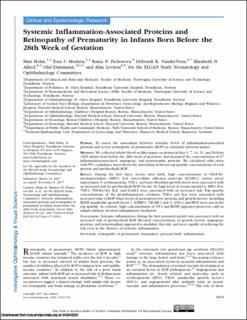| dc.description.abstract | PURPOSE. To assess the association between systemic levels of inflammation-associated proteins and severe retinopathy of prematurity (ROP) in extremely preterm infants. METHODS. We collected whole blood on filter paper on postnatal days 1, 7, 14, 21, and 28 from 1205 infants born before the 28th week of gestation, and measured the concentrations of 27 inflammation-associated, angiogenic, and neurotrophic proteins. We calculated odds ratios with 95% confidence intervals for the association between top quartile concentrations of each protein and prethreshold ROP. RESULTS. During the first three weeks after birth, high concentrations of VEGF-R1, myeloperoxidase (MPO), IL-8, intercellular adhesion molecule (ICAM)-1, matrix metalloproteinase 9, erythropoietin, TNF-a, and basic fibroblast growth factor were associated with an increased risk for prethreshold ROP. On day 28, high levels of serum amyloid A, MPO, IL-6, TNF-a, TNF-R1/-R2, IL-8, and ICAM-1 were associated with an increased risk. Top quartile concentrations of the proinflammatory cytokines TNF-a and IL-6 were associated with increased risks of ROP when levels of neuroprotective proteins and growth factors, including BDNF, insulin-like growth factor 1, IGFBP-1, VEGFR-1 and -2, ANG-1 and PlGF, were not in the top quartile. In contrast, high concentrations of NT-4 and BDNF appeared protective only in infants without elevated inflammatory mediators. CONCLUSIONS. Systemic inflammation during the first postnatal month was associated with an increased risk of prethreshold ROP. Elevated concentrations of growth factors, angiogenic proteins, and neurotrophins appeared to modulate this risk, and were capable of reducing the risk even in the absence of systemic inflammation. | en_US |

